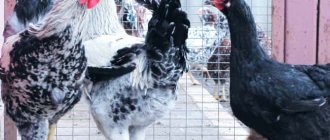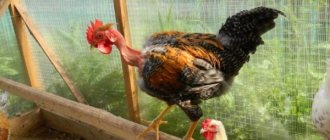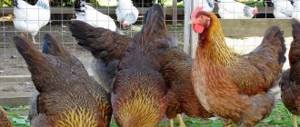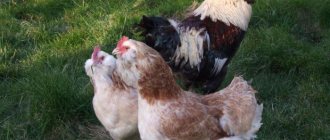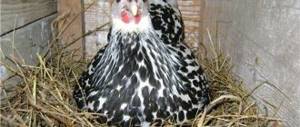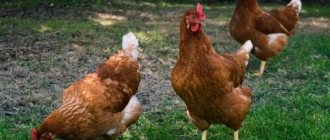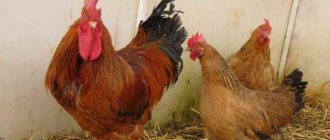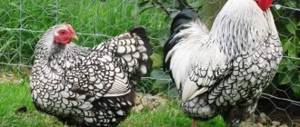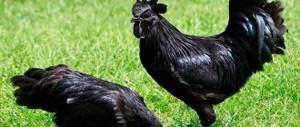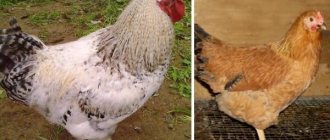Ornamental chickens are breeds that are genetically close to fighting breeds of chickens. Theoretically, they are bred for their original appearance (and in some cases, for the sake of experimentation), but many of these breeds can also boast good productivity - for example, bantams and araucanas lay eggs well. It is interesting that ornamental chickens are most often breeds bred in China (less often in other Asian countries - Japan, Indonesia, India), and many of them date back to ancient times. Back then, such unusual birds decorated the yards of titled persons. In some countries, ornamental chickens were bred for ritual purposes. And later these were breeds created to participate in exhibitions and fairs - in Russia, for example, Pavlovian chickens were bred.
Ornamental chickens are breeds that are genetically close to fighting breeds of chickens.
Dwarf chicken breeds
Decorative dwarf laying hens are popular due to their appearance. Their main feature is their small size and attractive appearance. But dwarf chickens are good laying hens; with the right approach, they can produce up to 130 eggs per season. Moreover, the eggs turn out to be quite large, weighing in the range of 40-50 g, and this is an excellent result even for normal-sized chickens.
Millefleur chickens are considered one of the most beautiful breeds in this category. They were bred quite a long time ago and mainly for aesthetic reasons. Indeed, these birds are prized for their bright, beautiful plumage. Although size was also an important factor - it was necessary to develop a breed that could be kept even in small spaces. The goal was achieved; the representative of the millefleur breed is a dwarf chicken.
These birds have very beautiful colors. Most often they are black and white and tricolor; there is a so-called porcelain color and even speckled blue. And the experiments continue. A beautiful chicken that can also lay eggs is an attractive option. And farmers are trying to breed chickens with unusual colors. Within the millefleur breed itself, there are several varieties, in particular, there are birds with “pants” on their legs. They are present in both chicks and adults.
Although millefleurs are a decorative breed, their character is by no means meek and pampered. They can behave quite aggressively if they feel threatened in any way. But in general, the birds are quite peaceful. And the roosters of this breed are famous for their care for females and offspring. And this is expressed not only in the fact that they protect other birds from danger. Such cockerels do not start pecking food first, but first invite the hens “to the table”.
As already mentioned, representatives of this breed are excellent layers. These dwarf hens are often used to incubate the eggs of other birds, such as quail and pheasants.
In general, millefleurs are quite hardy. But there are still certain rules for their maintenance that must be followed in order for them to feel comfortable. Like other chickens, they need dry bedding to prevent debris from sticking to their feathers. But there are also specific requirements. Chickens of this breed are more sensitive to drafts and dampness, so you need to make sure that the coop is warm and dry. In addition, these birds love heights, so it is better to make their perches higher. The diet should consist mainly of fresh grass and root vegetables.
Bantams and Chabot chickens
It is quite understandable that the most beautiful chickens are especially popular. For example, bantams, which are among the dwarf breeds. Historically, they were the first ornamental breeds. They were first bred in Southeast Asia, but it is difficult to say which country is their homeland - China or Japan. Although there are also normal-sized varieties, miniature birds are more prized. So for bantams, the most important feature is size. The weight of a rooster rarely exceeds 1 kg, and hens can be much smaller - up to 650 g. There are many types of bantams (Nanjing, Altai, etc.)
The egg productivity of such chickens is quite high, sometimes this figure reaches 130 eggs per year. Although for most individuals it is much more modest - 80-120 pieces per year. Chickens are excellent brood hens.
Like other ornamental breeds of chickens, bantams are quite thermophilic, and some of their varieties are sensitive to atmospheric humidity and do not tolerate precipitation well (this reduces their immunity and they die quite quickly). So the house should be dry, and the optimal temperature is +20...+25°C. Daylight hours for these birds should last 15 hours.
Decorative dwarf laying hens are popular due to their appearance.
The height of the perches for each case is determined individually, since there are varieties of bantams with normally developed wings, for which a high perch is suitable. But there are birds with poorly developed wings.
In addition, bantams, like all beautiful breeds of chickens, require special care in terms of hygiene procedures. After all, if you don’t take care of this, then long tails and feathered legs will simply lose their attractive appearance.
Most bantams have a fairly active character and need free range. Decorative chickens must have places for “bathing”: for this it is best to take sand, which is poured into separate basins. They need to be left free to forage. Although, of course, you need to monitor their diet, because these birds must receive a full range of vitamins and minerals in order to remain attractive.
The Shabo chicken breed was developed in Japan in the 17th century. They are often called Japanese bantams, although some researchers distinguish them as an independent breed. Two centuries later, these birds appeared in China, and from there they penetrated into Europe.
"Malaysian Serama Bantam"
Malaysian Serama chickens are the smallest breed of chickens.
Created by crossing Malaysian wild chickens with Japanese dwarf breeds.
The size of Serama chickens is comparable to the size of a pigeon: the weight of the roosters 300
-
650
g (record
250
g), chickens
250
-
300
g.
K u r y ry M M al al az az iy sk i e S S
- er
er a m a m y s on t o st o l k o o k k r o o k r o s h e c h e n y s, e, that something i x x so contain contain rzhat at d even not even not in the yard, e, but in the koom on na tn tny yh k le letk tk ah ah k k as d house ash ni ni x pi pi then that mts mts ev ev.
But No no od od ni nim m li just sh r raz az me mer ro ro m m s sl a v i t i sya s e this t a p p o r o o d o d a. A.
The appearance of Malaysian Seram chickens is also unusual: they have an incredibly high, almost vertical body posture, with the tail raised high at an angle 90
°, and a sh neck her in v yg yg well well ta tal l eb yazh yazhye y y do do do go go y. y.
Che Chem we ver rt ik ik al al al nn her her p p o s o ta t a v i i si si
- l
l not not e from from gigi b, b, t tem em p por or o o d y s is t e e e pt bird a. A.
Dl Dl I am this this og og o o su esche
- st
st vu vu et no n e o eo
- would
bych chny y s with po po so b otsot cen ki ki k kach ach es es tv a a pe pet tu tu ha ha,
- e
e m u n a g r o u d e s t a t i o n a v a y a n e s s q u i l l k o t t s chicks pollen t, t h e m e b b o l l e r the people are paying in the place where they are sitting ks ks te ter ry er er .
K u r s M a l a z a s i c S S e r e r m a m a m y s not unfruitful fr ot o d o v ity s, s, n e s s u t u t n s s e s ko ko l l ko d e d e s e y a t k o k o v ya i eggs ts c v y y yd, d, p o x o x o h o z h i m n a n a n e per e r e r ashes. e.
He He
- And
and very warmly warmly loving loving ones and from not unwifely ones, but they are different from each other m m ha ha ra ra kt kter er er om om .
K u r ry s M M a l a l a s i a s k i s s s e r e r s a m a m y y e v e r e r r a d e d e r e d e r e d s o f t h e i m a s os t e p p or or o od od is isty you x x pt bird its o o che chen n in high vysok oka, a, n o o b r a c k o v a n an n a n n y y mo mo lo lo lo day day yak s n n e s n e n e n a n c h i t e t e t e l l n n y m i m n n e d e o s o s t a t tk t k a m a m i i p s o l d e a e t s i under d d os os tu mon mon oy oy ts e e.e.
Ku Kury ry “Ma Mala la lazi zi yis ka kaya ya Se Ser ra ra mama mama”
- ri
and and by in in es es y: y:
In general, we have a lot of com- plete s e k k u r u r y Ma Mala la la zi zi s y s k e e Se Sera r a m a r a m e o o e
- what
n n n d dor or og og and and and and ch that about customs » on on va vari
- ri
no matter what
- A
this is this ra ra no
- Not
Russian kings
In Russia there is another dwarf species - Russian kinglets. Scientists are still debating whether they should be classified as a separate breed. Those. Russian kinglets are a type of bantam. They are first mentioned in N. Teplov’s book “The Poultry Yard,” which was published in 1774. In those days, wrens (as they were called, most likely, because of their small size, because the wren itself is one of the smallest birds found in Russia) were precisely the decoration of poultry yards. They were bred to walk in palace parks.
This dwarf species was probably one of the first in its category to be represented in Russia. Although a number of scientists believe that kinglets were bred on the basis of bantams, there are researchers who believe that this decorative breed is an independent group. They believe that the kinglets were bred neither from bantams nor from wild birds, but that their ancestors were large chickens with a similar appearance. Geneticists have established that the birds belong to the group of European breeds, but nothing more precise can be said yet.
Be that as it may, this decorative breed was first exhibited as an independent group in 1878 at the Moscow acclimatization exhibition. Then two varieties were presented at an exhibition in Kharkov in 1885.
Kinglets are a fairly productive breed. They produce 135 eggs per year, although they are quite small, the size of an elongated ping-pong ball. The average weight of an egg is 44 g.
Kinglets are very beautiful chickens. But at the same time they are really very small. The average weight of a rooster is only 1 kg, and that of a chicken is even less. The less weight, the more it is valued. These decorative chickens are distinguished by their rare endurance. They rarely get sick and tolerate cold well. They are considered excellent hens, so they are often given pheasant eggs.
Malaysian Serama
The smallest breed of chicken in the world is the Malaysian Serama. It was released relatively recently. To do this, breeders crossed Japanese dwarf breeds with wild chickens of Malaysia. As a result, a new breed was obtained, the representatives of which are quite comparable in size to pigeons. Malaysian serama is lightweight. Roosters can reach 650 g, but usually their weight is much less, and the smallest birds can weigh 250-300 g. Thanks to this, such birds can even be kept in indoor cages at home.
In addition, the Malaysian serama boasts an unusual appearance. Characteristic features are a high body posture, a tail raised at a right angle, and a neck arched like a swan. The greater this bend, the more thoroughbred the bird is considered.
The Malaysian Serama is not particularly productive. Such chickens lay only a few dozen eggs a year, and even those are similar in size to quail eggs. Nevertheless, the breed is popular, not only in Malaysia, but also abroad. Although such chickens are quite expensive, including because they are not fertile, and there simply cannot be an excess supply on the market.
This breed requires special care. Moreover, this applies to feeding, hygiene, and many other aspects. The Malaysian serama is heat-loving; such birds are quite demanding in terms of living conditions. At temperatures below +25°C they stop laying eggs. But for all their pampering, such cockerels and hens are distinguished by a rather lively character.
Chickens of the decorative breed "Malaysian Serama"
This decorative breed was bred in Malaysia not so long ago and was obtained by crossing two species of birds: the local Malaysian wild (“ Ayam Hutan
”) and the dwarf Japanese (“
Ayam Katik
”) and (“
Ayam Kapan Bangkok
”).
The main feature of Serama
" is its tiny size. Today, these are the smallest chickens in the world. The weight of adult cockerels rarely exceeds six hundred and fifty grams, and the weight of laying hens is even less (about three hundred grams). The size of these birds can be compared to the size of an adult pigeon.
Malaysian chickens are not very productive (during the year, a laying hen produces only about sixty eggs, the weight of which does not exceed thirty grams), and the egg size is only slightly larger than a quail egg (five times smaller than a regular chicken egg). The good news is that the eggs of Malaysian chickens are extremely tasty, and the decoration of the birds shines with variety, so they can become a decorative addition to any poultry yard or homestead.
The hens and cockerels of the breed have a very unusual and original appearance, since the body position of these birds is almost vertical, the tail is raised at an angle of ninety degrees, and the neck is arched like a swan. It is believed among breeders that the more thoroughbred the bird, the stronger its neck bend and the straighter its vertical stance.
It is noteworthy that in Malaysia every week a beauty contest is held among chickens of this breed, in which up to four hundred poultry farmers from all over the country simultaneously take part.
For purebred cockerels, to assess the quality of their natural body, small chicks are placed on the chest and the more babies that fit on the chest (according to the standard, at least three chickens should fit), the higher the thoroughbred of the bird.
True lovers of the Malaysian breed, starting from the age of two months, give the chickens a special massage of the chest and tail, thus accustoming the birds to a vertical stance. Thoroughbred cockerels are gradually accustomed to taking baths, where they swim for better development of their wings and chest. There are also special devices (clamps) that help birds position their tails at the correct angle (by analogy, this is how the ears of Doberman dogs are positioned).
A slightly arched chest and a tail set at an angle of less than ninety degrees are considered a breed defect and such chickens are discarded.
Thanks to the above features, cockerels have a chic exterior and brightly colored feathers. The legs are set wide apart, the plumage is not very dense. The beak is yellow, curved downwards. The appearance of the chickens is somewhat more modest.
Due to its miniature size, the breed thrives in small cages and can successfully compete with parrots, canaries and other birds. However, these chickens are heat-loving birds and do not tolerate drafts and cold, so many poultry farmers consider them capricious and overly pampered “persons”.
Birds reach sexual maturity at the age of six to seven months, and sometimes even later.
When the air temperature is below twenty-five degrees Celsius, the hen stops laying eggs, and the periodicity of her egg production is as follows: after five or six eggs, which she produces daily, there is a break lasting from seven to ten days.
Malaysian breed hens are endowed with an excellently developed brooding instinct, but are not good “mothers”. The fact is that as soon as the chickens reach seven days of age, they must be urgently removed from the hen, otherwise the unlucky “mother” will peck all the offspring to death. This is the peculiarity of these chickens. However, the viability of Serama
"is very high and the survival rate among them can reach one hundred percent.
Unlike their larger relatives, hens and cockerels of the Malaysian breed are very mobile, incredibly active and excellent at staying on the water. In addition, chickens are distinguished by their friendly nature, high sociability and cheerful disposition.
The smaller the weight of the chickens, the more they are valued on the market, so birds are classified based on body weight. There are three ranks or categories of thoroughbred:
Shaggy-legged chickens
Shaggy-legged chickens are a relatively new breed of chicken. Although most ornamental breeds were developed in Japan and China, this variety is of Russian origin. It was created by specialists from VNITIP based on other Russian varieties - the Oryol and Pavlovsk breeds. It’s interesting that shaggy-legged chickens are completely different from their “ancestors” - what a genetic miracle! However, when it comes to resistance to external conditions and productivity, the breed has taken all the best features from its prototypes.
Shaggy-legged chickens are similar to Ukrainian ear-eared chickens, but they are two different breeds. These birds look very specific due to their legs covered with small feathers and a spectacular beard under the beak. They have funny sideburns on their heads. Their color is always light brown. This decorative breed cannot be called dwarf. The weight of an adult rooster is up to 3 kg, and that of hens is slightly less.
Hens begin to lay eggs later than representatives of other breeds. But they can boast of higher productivity - up to 150-160 eggs per year, and it is interesting that they always have a light brown shell.
Thus, ornamental chicken breeds are quite popular in the world. Despite the fact that they are bred mainly for participation in exhibitions, some of these birds can also interest ordinary farmers due to their high egg production, combined with an interesting appearance.
The smallest chickens in the world - Malaysian Serama
The Malaysian Serama chicken breed is young, their history is not even 20 years old. The name of the breed reflects the name of the country where they were bred - Malaysia.
The breed is based on Japanese dwarf breeds crossed with wild chickens from Malaysia. Initially, selection was carried out by professional poultry farmers.
Over two decades, Malaysian Serams - the smallest chickens of all existing breeds - have become known throughout the world, but, of course, they cannot yet be called a common breed.
One of the limiting factors in the victorious march of these little ones through poultry yards around the world is the fairly high cost.
But this does not stop true poultry farmers, so hens and cockerels of the Malaysian Serama breed can increasingly be found in Russian poultry houses.
